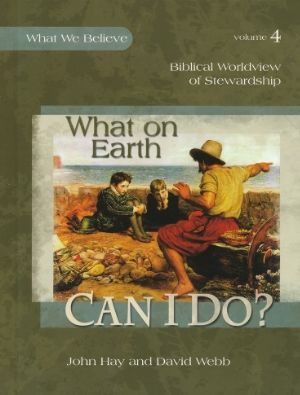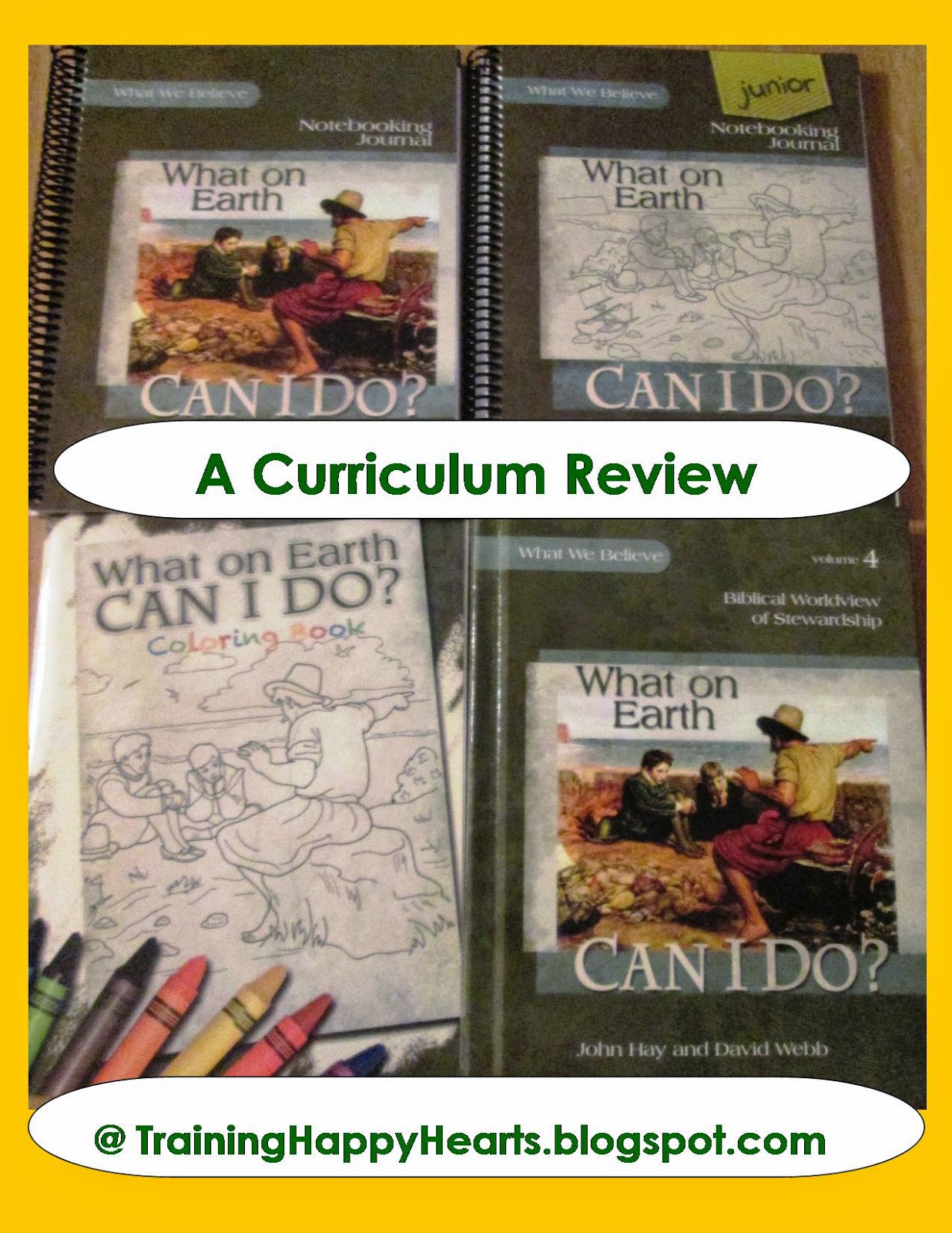Note: This post contains affiliate links to a favorite educational products provider of ours: Apologia Educational Ministries. Read full disclosure here.
Although we tend not to be "textbook" learners here, I have heard fantastic things about Apologia Educational Ministries. So, when I was offered an opportunity to review their What on Earth Can I Do? textbook and the accompanying What On Earth Can I Do Notebooking Journal, What on Earth Can I Do? Junior Notebooking Journal and What on Earth Can I Do? Coloring Book I decided to go for it.What Is What on Earth Can I Do?

What on Earth Can I Do? ($39) is a 290+ page hard cover text about stewardship with a Biblical worldview. It is broken down into eight lengthy lessons designed to be flexible and adaptable to family needs by breaking it down into smaller chunks based on each lessons parts:
- the big idea that introduces the lesson's theme
- a short story that shows how children put their worldview into action (and in the first several lessons is a continuing story that my children loved which follows a family living in Great Britain during World War II)
- adaptations of the Parables of Jesus
- faith building helps such as Hide It In Your Heart Bible verses to memorize, What Should I Do? sections that highlight specific godly character traits and a concluding prayer
- articles on interdisciplinary topics related to the main text, including such people and things as Hitler, Corrie Ten Boom, Winston Churchill, Maria Von Trapp, Victory Gardens, etc.
- traditional lesson helps such as a brief What You Will Do list that presents learning objectives for the lesson, Think About It questions to spur conversation and solidify concepts and defined Words You Need to Know
All of these features are well laid out with graphics, photographs, etc. which make reading easy and engaging.

The What On Earth Can I Do Notebooking Journal ($24) is a softcover spiral bound book that contains 48 daily lesson plans as well as pages for:
- note-taking
- answering questions
- defining vocabulary words
- writing Bible verses
- noting how lessons apply to your own life
- enjoying crosswords and wordsearches
- creating mini-books
- writing or drawing prayers
- recording how God has answered prayers
- noting how you've seen God in everyday life
- recording how you are ministering to others
- reviewing lesson materials
- finding additional resources on lesson topics.
I would say it has everything you might want for notebooking through the text, but, as my son pointed out, it does not contain coloring pages. Yes, even older kids sometimes like to color, and, if they are going to in this journal, they will need to do so from scratch.

The What on Earth Can I Do? Junior Notebooking Journal
($24) is a step-down in age/skill level from the above journal. It, too, is a spiral-bound softcover book. In addition to 48 lesson plans, it contains:
- blank note-taking pages
- coloring pages
- fill-in-the-blank word to know pages
- places to rite Bible verses
- places to answer questions about how lessons apply to life
- word puzzles
- mini-books
- prayer and praise report pages
- resource lists
- and more.

The What on Earth Can I Do? Coloring Book ($8) contains 64 captioned illustrations which include Bible stories and quotes, historical figures and more. It's perfect for youngsters who want to be included in lessons.
How We Used What on Earth Can I Do
When I first received the What on Earth Can I Do? textbook and the accompanying Notebooking Journal, Junior Notebooking Journal and Coloring Book, I was impressed by how complete the resources were and envisioned how tidily I could weave it into our homeschool endeavors if we were in a more structured phase of learning. However, since we were in one of our more relaxed, experiential and unschool-y seasons of life, I did not use the materials this way.
Instead of following the beautifully laid out lesson plans, I simply gathered my kiddoes to read the main text together one day and then continued to read segments of it at bedtime, during midday rest time, after picnics, etc.
Likewise, I did not present the journals and coloring books as "work". Rather, I invited the children to the table and let them know that we were blessed with the opportunity to check out three different special journals to go along with the book we had been reading together. When I did so, my two younger children immediately set to work coloring pages while my oldest hemmed and hawed that his book did not have coloring pages in it.
Soon enough, though, even my oldest dug in. He sketched on a note-taking page about the air raids we had read about earlier in the main text.
We continued to use the materials in this casual way, and it is working for us. As a matter of fact, as I write this review, my three children are enjoying dramatic play about bomb shelters and gas masks as inspired by a portion of the text (pictured above) that they revisited earlier today.
However, in a later phase, I can definitely see yet-to-be completed readings and journal pages being fodder for more structured, traditional and even independent learning endeavors.
A Balanced View
One the "Yes, this works!" side for our family:
- As Christian homeschoolers that lean towards unschooling, we do not separate faith from learning from life. Thus, I appreciate that What on Earth Can I Do? is not a secular, dry textbook. Rather, it is a readable book with a Christian worldview that my children and I enjoyed at bedtime and during other read aloud times sprinkled throughout our days.
- I love homeschool resources that the entire family can use together. Because What On Earth Can I Do Notebooking Journal, What on Earth Can I Do? Junior Notebooking Journal and What on Earth Can I Do? Coloring Book are targeted to different age and skill levels, What on Earth Can I Do? definitely becomes accessible to multiple ages.
- Just as we don't draw lines between life and learning here, we also blur lines between different typical subjects of study. I appreciate, then, that What on Earth Can I Do? crosses between faith studies/family devotional time, history, fine motor skills, handwriting, comprehension, etc.
On the "Hmm, you might want to consider..." side"
- What on Earth Can I Do? is meant for children in grades one through six. We used it with children ages three to eight, and although all of them were engaged by it, I honestly think that the beginning of the book -- which starts with the "heavy" topics of World War II, Hitler and Nazis -- might be a bit much for some sensitive young listeners. So, be forewarned and be sure to pick and choose which portions of the main text to read aloud.
- The notebooking journals are a wonderful resource for the "right" kinds of children and families. They provide opportunities to color pre-drawn pictures, do puzzles, answer questions, create mini-books, take notes, respond to open-ended questions, etc. However, for kids like mine they still seemed to "workbooky" to be 100% appealing.
That said, I am still impressed with the thoroughness of the What We Believe series What on Earth Can I Do? textbook and the accompanying Notebooking Journal, Junior Notebooking Journal and Coloring Book that I plan to continue using these resources my children at their request throughout the summer and into the fall.
Learn More
You can find Apologia Educational Ministries on:
Plus, if you'd like to know what others think about What on Earth Can I Do? and how people are using it, there are plenty more reviews to browse.






